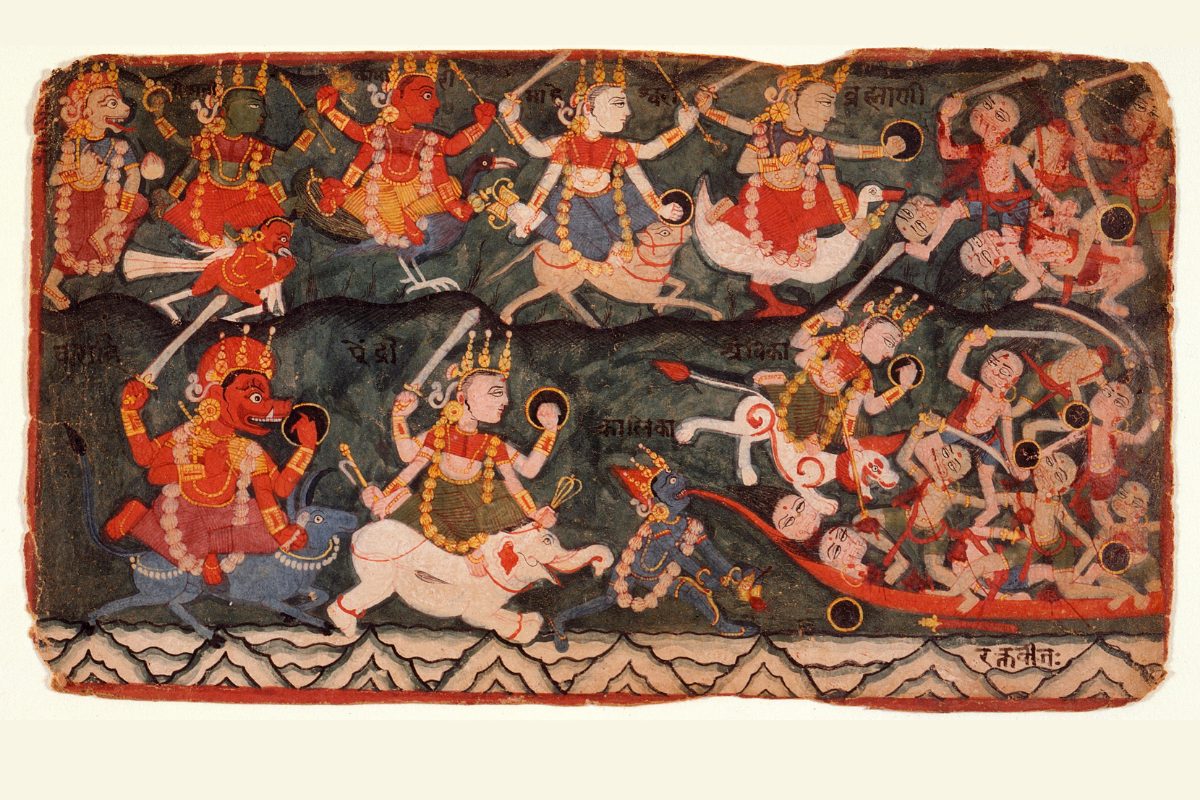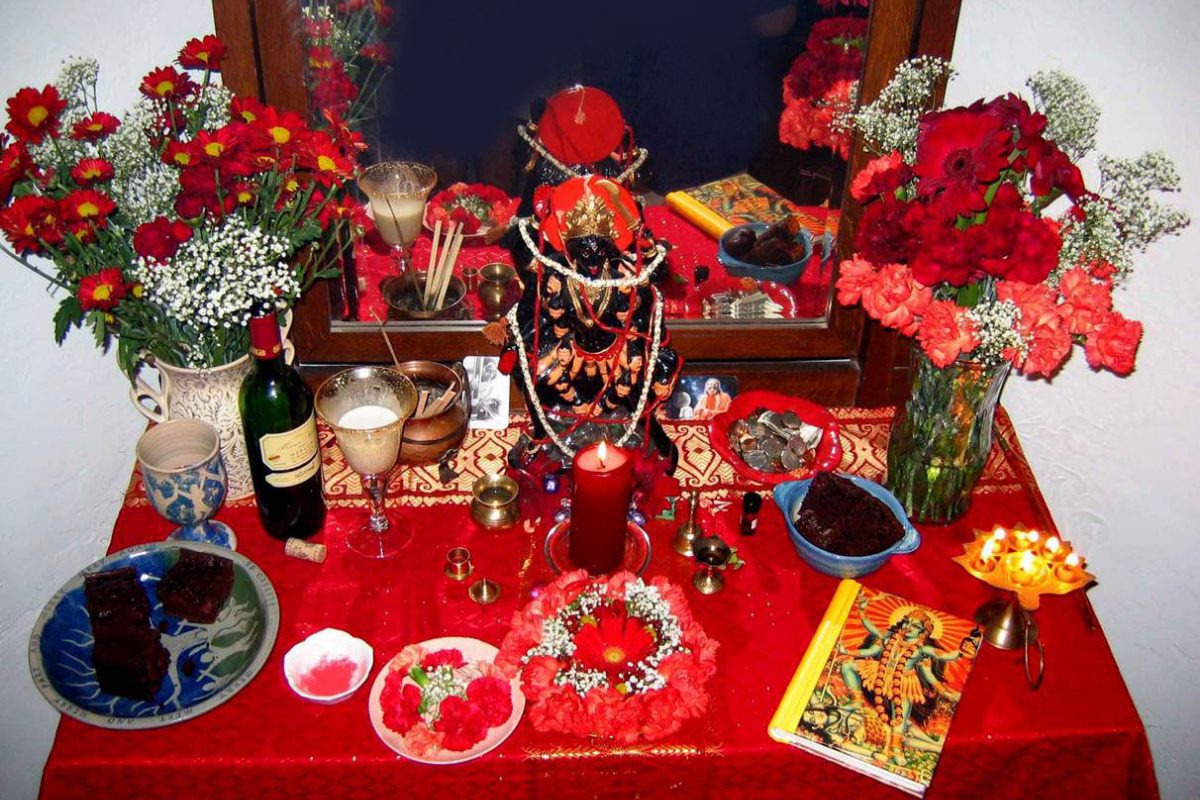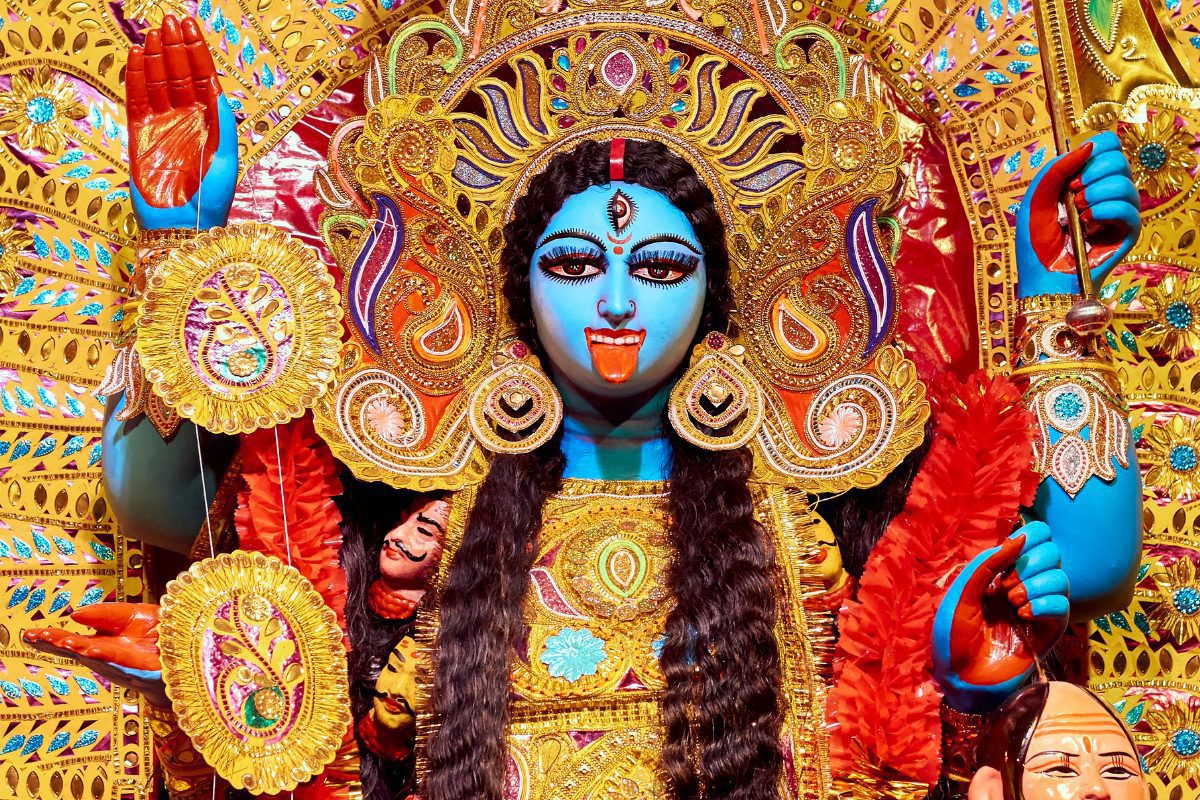Since I joined the Mt Shasta Goddess Temple at the end of 2020, I’ve dedicated every month to a different goddess. In January, it was Prajñāpāramitā, and it was Themis in February. I’ve dedicated March to Kali, the Hindu goddess of creation and destruction and the preserver of time. I’ve had a relationship with Kali for more than 15 years. When I initiated into Georgian Wicca in 2007, the Craft name I adopted is associated with her. Still, I am always learning about this complicated goddess. Here’s an introduction to this oft-misunderstood goddess, how I approach her, and where you can learn more about Kali.
Kali, the primordial cosmic energy
Like many deities, Kali has different origin stories. In her most famous legend, Durga, a protective warrior goddess who combats the evils that threaten peace, and the Matrikas (a group of mother goddesses) summoned Kali during their battle against the demon Raktabīja. The goddesses could wound and kill Raktabīja’s, but every drop of his blood created a duplicate of the demon, and countless clones appeared on the battlefield. Kali opened her mouth, rolled out her tongue, caught the drops of Raktabīja’s blood, and the goddesses defeated the demon.
Kali became drunk on the blood of the demons, and the gods feared that, in her frenzy, she would destroy the universe. Her consort Shiva laid down at her feet, and when Kali stepped on him, she calmed.

Kali is sometimes said to have emerged from Durga’s forehead and embody Durga’s wrath. Another text describes Kali as arising from the sleeping body of Vishnu, the supreme being who creates, protects, and transforms the universe in the Hindu tradition of Vaishnavism.
Kali is more often regarded as the wife of Shiva, the supreme god in the Hindu tradition of Shivaism. Her name, Kālī, is the feminine form of Kāla, an epithet of Shiva, and means “time”. She is Shiva’s Shakti, the primordial cosmic energy of the universe that is creative, sustaining, and destructive. Without Kali, Shiva is a corpse.
There are various depictions of both Shiva and Kali. It’s helpful to think of Shiva as pure consciousness, Kali as energy, and their merging represents reality.
The symbols of Kali
Many people find Kali’s appearance frightening, which has led her to be popularly seen in contemporary Paganism and Witchcraft as a Dark Goddess and a destroying force. She is a Dark Mother and a Destroyer, but not in the way many might imagine. For many devotees across the Indian subcontinent and the world, Ma Kali is a benevolent mother who protects from misfortunes and delights in their childlike qualities.
Kali is depicted in many ways. One of her most popular forms is Dakshinakali, and a closer look at her symbols gives us a better sense of who the goddess is and what she does.

Kali is the force of time, the darkness from which everything was born. Her dark skin, black or blue, represents the transcendent void and the infinite nature of time and space. She is nude, garbed in space and free from illusions. Her body may be emaciated or voluptuous, representing her all-giving nature and her eroticism. Her wild hair represents boundless freedom, and each strand is a soul; all souls have their roots in Kali. With her three eyes, the sun, moon, and fire, she sees the past, present, and future. Her red tongue is passion, activity, consumes all, and tastes the forbidden. Her white teeth or tusks are purity, goodness, balance, and peacefulness.
Kali wears a garland of severed heads. These are sometimes said to number 108, an auspicious number in Hinduism, and the number of countable beads on a mala. The severed heads are also said to number 47, 50, or 51, associated with the letters of the Sanskrit alphabet, each of which represents a form of energy or a form of Kali. She is the mother of language and all mantras. Hands are the principal instruments of work, and Kali’s skirt of severed human arms represents the action of karma, the cycle of which is severed through devotion to her.
Kali has four arms, representing the complete circle of creation and destruction within her. She offers blessings with her two right hands; she makes the mudrā (gesture) of reassurance and safety, and bestows boons. In her left hand, she holds the blood-covered sword of wisdom, which destroys demons and obstacles to enlightenment, such as ego, represented by the severed head.
Kali’s dwelling place is the cremation grounds, a place of fire and dissolution. Kali dwells in the devotee’s heart, and the cremation grounds symbolise the inner fire that dissolves our attachments and burns away our ignorance and limitations.
Kali is a goddess of death and destruction and, therefore, a vehicle of liberation. She is a Mother because she is the ultimate manifestation of Shakti. The Shaktisangama Tantra says:
Woman is the creator of the universe, the universe is her form; woman is the foundation of the world, she is the true form of the body.
In woman is the form of all things, of all that lives and moves in the world. There is no jewel rarer than woman, no condition superior to that of a woman.
The worship of Kali

The worship of Kali varies. Common elements include meditation, repeating mantras, rites, offerings, and animal sacrifice in some temples. My practice has also changed over the years and has included simple and more extended pujas (devotional rituals) and even Wiccan-style rituals. Currently, I maintain a permanent shrine to Kali and make offerings of red flowers, water, incense, rice, and other various items from time to time.
I view Kali as a benevolent, transcendent, cosmic Mother. She grants freedom by removing our illusions so that we can see ourselves and the world clearly as it is.
If you would like to begin exploring a relationship with Kali, I suggest setting up a small shrine for her. Include a statue or other image and a black or red candle. Make simple offerings: water, rice, red flowers (hibiscus are her favourite), red fruits, and Kali also like sweets. Meditate and speak to her.
There is so much more than can be said about Kali. In future entries, I’ll explore Kali’s various forms, yantra, mantras, tantra, puja, her revolutionary power, and more.
Resources
Below are resources to help you learn more about Kali. Come back from time to time. I’ll add more resources to this page.
Articles
- What is Tantra? by The British Museum
- Demystifying Tantric sex by The British Museum
Books
- Kali: The Black Goddess of Dakshineswar by Elizabeth U. Harding
- Kali: The Feminine Force by Ajit Mookerjee
- Kali Meditation – Personal Sadhana Practices to the Divine Mother by Yamajit
- Kali Meditation Book II: Kali Yantra Sadhana by Yamajit
- Kali Meditation Book III Chamunda Sadhana: Daily Practices for the Oldest Form of Ma Kali as Worshipped in the Kathmandu Valley by Yamajit
- Singing to the Goddess: Poems to Kali and Uma from Bengal by Rachel Fell McDermott
- Twenty-Four Aspects of Mother Kali by Babaji Bob Kindler
Videos
I have created a YouTube playlist with videos of Kali and related topics, and I will continue to add to it.
Visit the YouTube channel Tridevi Chamunda Mandir With Yamajit, author of several books on Kali listed above.
You may notice that there are no affiliate links to Amazon here. The e-commerce giant is convenient, and it would be nice to earn a few cents from those sales, but I encourage you to shop at your local, independent bookstore or visit your local library. If you’d like to support my blog, you can buy me a coffee.

